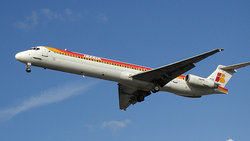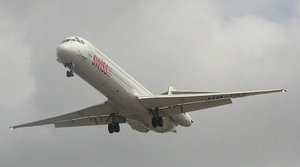Douglas DC-9
|
|
The Douglas DC-9 is a twin-engined jet airliner, first manufactured in 1965 and, in much modified form and under a succession of different names, still in production today as the Boeing 717.
DC-9_UR-CBY.JPG
Douglas launched the DC-9 development project in April 1963, intending the DC-9 as a short-range companion to their larger four engined DC-8. Unlike the competing but slightly larger Boeing 727, which used as many 707 components as possible, the DC-9 was an all-new design, using two rear-mounted Pratt & Whitney JT8D fanjet engines, a small, highly efficient wing, and a T-tail. The original version had five abreast seating for 70 to 90.
The DC-9 prototype flew in February 1965 and entered service with Delta Air Lines in December of that year. It was an immediate commercial success, and 976 were built by Douglas who then merged with McDonnell Douglas (MDC). In 1983 the world saw the advent of the DC-9-80 series (MD-80) which was a lengthened DC-9-50 with a higher MTOW (maximum take-off weight) and the ability to carry more fuel. The MD-80 was then developed into the MD-90 family. The MD-90 sports IAE V2500 engines and a glass cockpit as the MD-88 does. The last variant of the family was the MD-95, which is now marketed as the Boeing 717-200, in light of the merge between MDC and Boeing in 1997.
With total sales of over 2400 units, the long-lived DC-9 family is one of the most successful jet airliners ever made, ranking third behind the Boeing 737 (over 5100) and Airbus A320 family (just under 3000).
DC-9 models

- DC-9-10 The earliest and smallest DC-9 was 27 m long and had a maximum weight of 41 tonnes. Power was a pair of 54.5 kN Pratt & Whitney JT8D-5s. 137 were built.
- The DC-9-15 and DC-9-20 were minor variations on the -10 theme. The -15 added more fuel capacity and higher weights, the -20 used the more powerful engines and improved wings of the -30 to improve hot and high performance. Only a small number of each were made.
- The DC-9-30 was the definitive model with 662 eventually produced. The -30 entered service in February 1967 with a 4.5 m fuselage stretch, wingspan increased by just over 1 m, weight increased to 55 tonnes, and 64 to 67 kN JT8D-9 or JT8D-11 engines. About 380 -30s remained in commercial service in 2002. Many of these –30 (with side cargo door) types were utilized by the Military in C-9A Nightingale Medivac configuration for the U.S Air Force and the C-9B Skytrain II version used by the U.S Navy and Marines for fleet logistics support (the Navy’s airline), many of these types were fitted with additional fuel tanks installed in the lower cargo hold to augment the aircrafts range for overseas missions along with Infra-red (IR) scramblers to counter heat seeking missile threats in hostile environments.
- The further stretched DC-9-40 entered service with SAS in March 1968. With a 2 m longer fuselage, accommodation was up to 125 passengers. The -40 was fitted with a variety of Pratt & Whitney engines of between 64.5 and 71 kN. 71 were produced.
- The largest DC-9 to fly under that name was the DC-9-50, which has another 2.5 m fuselage stretch and seats up to 139 passengers. It started revenue service in August 1975 and, aside from the size increase, included a number of detail improvements, a new cabin interior, and quieter JT9D-15 or -17 engines in the 70kN class. McDonnell Douglas delivered 96.
- Typically known as the MD-80, the next members of the DC-9 family were the -81/-82/-83/-88 and the shortened MD-87 series. The MD-80 designation was a marketing move to show that McDonnell Douglas had an airliner for the 1980s. The "Series 80" versions sport cockpit, avionics and aerodynamic upgrades along with the more powerful, efficient and quieter JT8D-(200) series engines, which are a significant upgrade over the smaller JT8D-15, -17, -11, and -9 series. The DC-9-80 series aircraft also have longer fuselages than their older DC-9 counterparts, as well as an increase in range. The MD-80's production ended in 1999,.
- The MD-90, was introduced in 1993 and was basically a 1.4 m longer, updated version of the MD-88 with a similar EFIS (glass) cockpit and even more powerful, quieter and fuel efficient engines than the MD-80 models, the IAE V2500 Series engines. MD-90 production ended in 2001 with the last MD-90's being built under contract in China.
- The Boeing 717 was slated to wear the MD-95 badge until Boeing and McDonnell Douglas merged in 1997. This variant is the last update to the DC-9 airframe family. The MD-95 program was re-named and the Boeing 717 entered service in September of 1999. The aircraft is 1.45 m longer than the DC-9-30 and has the same basic cockpit and cabin updates as the MD-90 but is powered by new Rolls-Royce BR715 engines. The B-717 is to end production in 2005. It will be the end of the civilian Douglas aircraft in production.
Specifications
External links
- Boeing DC-9 Website (http://www.boeing.com/commercial/dc-9/)
- Boeing MD-80/MD-90 Website (http://www.boeing.com/commercial/md-80-90/index.html)
- MD-80 International Forum (http://www.md80.net)
- Italian MD-80 Site (http://www.md80.it)
| Related content | |
|---|---|
| Related development | |
| Similar aircraft | |
| Designation series | |
| Related lists | |
|
Lists of Aircraft | Aircraft manufacturers | Aircraft engines | Aircraft engine manufacturers Airports | Airlines | Air forces | Aircraft weapons | Missiles | Timeline of aviation |
es:Douglas DC-9 id:MD-82 nl:Douglas DC-9 ja:DC-9 sv:McDonnell Douglas MD-90

